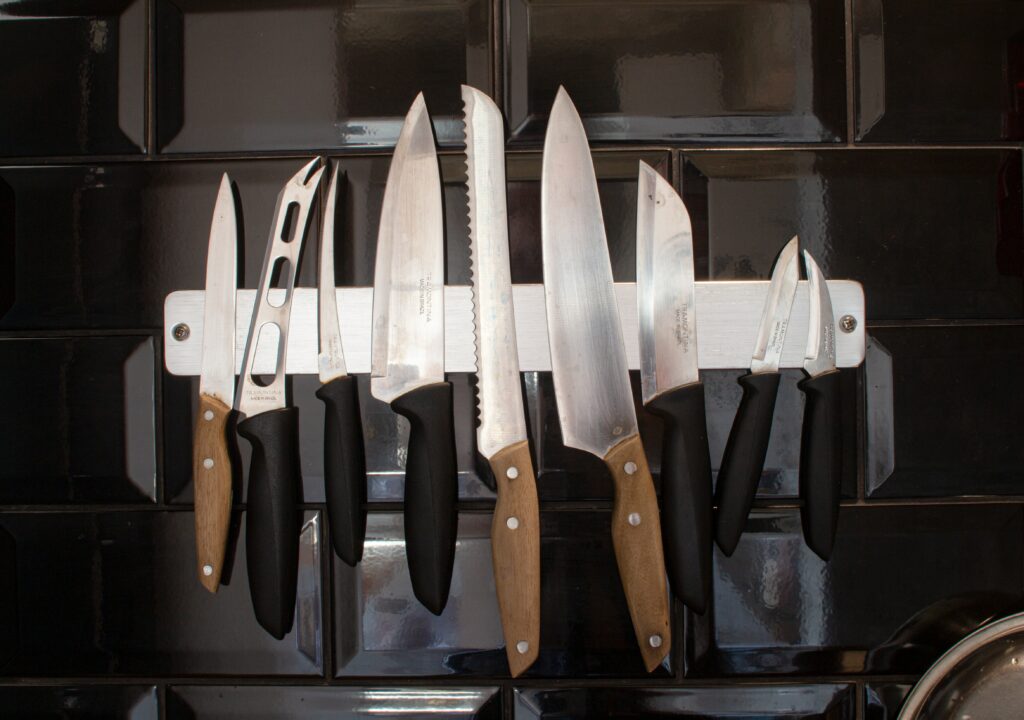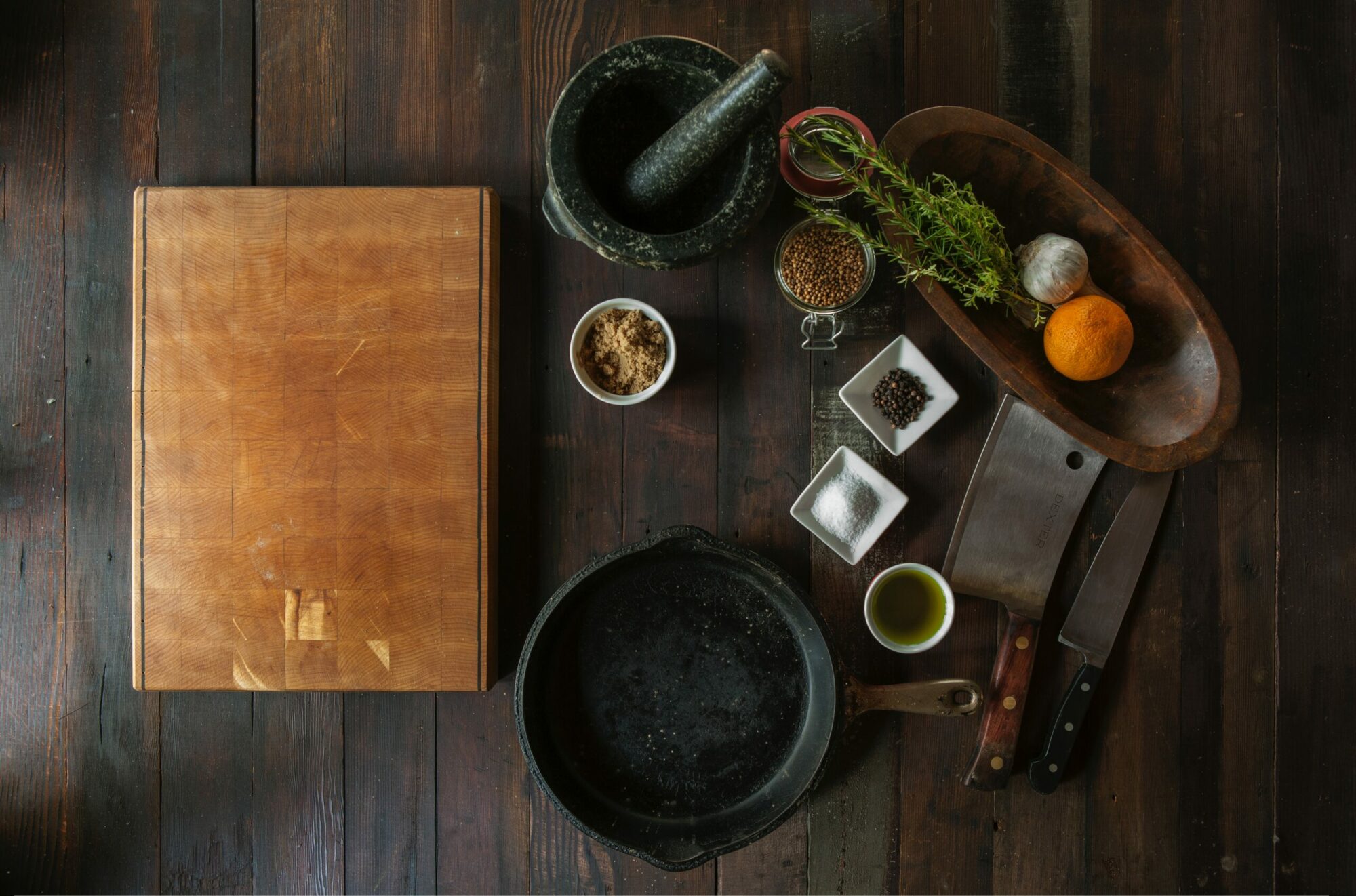Let’s Talk Knives
The Essentials
The Chef’s Knife
This knife has a broad tapering blade, sharp tip, and chunky handle. It’s used for a variety of tasks in the kitchen and is a great knife to get started with as they are sharper, stronger and do more work for you in the long run than smaller knives will. An 8-inch blade with a handle that feels best to you, is a good place to start. When you feel more confident, you can work your way up to the 10-inch blade which is considered to be more efficient. Overall you want to look for a blade that is thicker at the base than at the tip and you want to look for a handle that feels comfortable in your hand.
The Utility Knife
These are small knives and it’s worth having a few in your kitchen. They have short blades, 3-4 inches long which generally makes them pretty easy to control. These knives are best for small and soft ingredients. Due to their difficulty to sharpen, it’s best to look for inexpensive, thin bladed knives with plastic handles so that they can be replaced when needed.
The Serrated Knife
It’s best to start off bigger with a Serrated Knife. A 10-inch blade is standard and is useful in a variety of ways from slicing through firm rinds like watermelon or pineapple or tackling thicker jobs like butternut squash and pumpkin. This knife is also used to slice bread, cakes and make neat slices on soft ingredients like tomatoes.
Knives for Days
Carving Knife
This knife has a sharp pointy tip and a narrow blade compared to something like the chef’s knife. It’s designed for cutting cooked cuts of meat and poultry and it’s design is better to cut into joints and along bones.
Santoku Knife
This knife is often interchangeable to the Chef’s knife. Rather than being curved, the blade is straight and thus is better suited for up and down movements rather than rocking back and forth while carrying out cutting jobs.
Boning or Filleting Knife
These knives have long thin blades and curved sharp tips. They are designed for cutting raw meat, poultry and fish. A Boning Knife has a rigid blade which is designed for meat and birds. Filet knives have flexible blades which help to follow the curved shape of fish skeletons and chicken breasts.

How to Care for your Knives
Let’s start by asking a basic question. When was the last time you sharpened your knives? For most home cooks or those brand new to cooking the answer is usually: “I have to sharpen my knife?”.
Keeping your knives sharp not only prolongs the life of your knives, but it also saves you time and frustration in the kitchen, consider it a win win. Additionally, contrary to popular belief, sharp knives keep you safer in the long run because sharp knives do their job, they cut things, while dull knives slip and instead just hurt you.
Sharpening
The best way to test whether or not a knife is dull is to test it on a piece of paper; to do this run the blade along the edge of a piece of paper to see if it cuts, if it’s not ‘cutting it’ then it needs to be sharpened.
- Manual sharpeners are recommended as they give more control on the finished product
- Use gentle pressure when pulling the knife through and test the sharpness often as you work
Honing
What’s the difference between sharpening and honing you may be asking yourself? Honing makes the blade of a knife straight and is done by using a sharpening steel, it maintains the blade’s sharpness rather than actually sharpening it. Sharpening steels are made of various different materials such as metal, ceramic, or stone and all are abrasive and rod shaped. To hone a blade, the blade is run along the abrasive rod over and over.
A fun tidbit, professional chefs often hone their knifes daily, sometimes even multiple times a day to ensure the longevity of their knives. Are home cooks expected to do the same? Of course not, but learning how to hone can make it so that it can be incorporated into a weekly care for your knives. It’s quick (once you’re trained and confident), can be fun, and can help you feel like more of a serious cook at home.
Tips and Tricks
- Don’t use cutting surfaces that let your knives get dull
- Avoid Glass Cutting Boards
- Wood Cutting Boards are a good start but may carry bacteria if not sanitizzed properly
- Thick plastic is a good option for most home cooks
- Some knives can’t be sharpened
- Small utility knives with very thin flexible blades (will need to be replaced instead)
- Serrated knives
- Can get them professionally sharpened (House of Knives or a local knife store)
- It’s best to wash your knives thoroughly by hand
- This allows for you to check for any chips in the blade and ensure their cleanliness
- Some knives just aren’t made for the dishwasher
- Knives with wood handles
- High-carbon steel bladed knives
- Any sensitive material blades (brittle ceramics etc)
- Don’t wait for your knife to get dull before giving it some love
- Keeping your knives sharp and maintaining their sharpness is the easiest way to keep yourself safe and efficient in the kitchen
- Start by giving them a quick honing and sharpening every few weeks until you feel comfortable with taking care of them on a more regular basis
- Keeping your knives sharp and maintaining their sharpness is the easiest way to keep yourself safe and efficient in the kitchen
